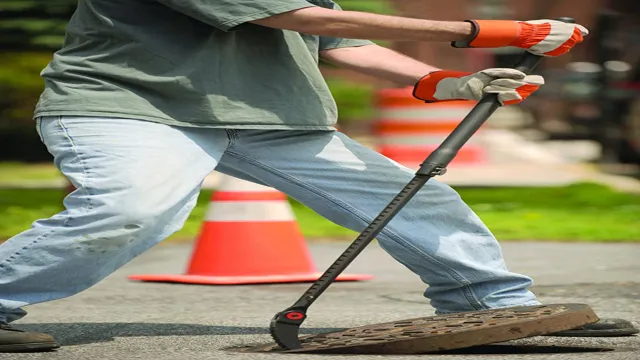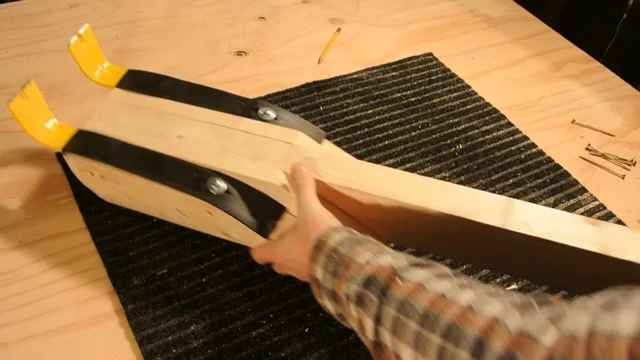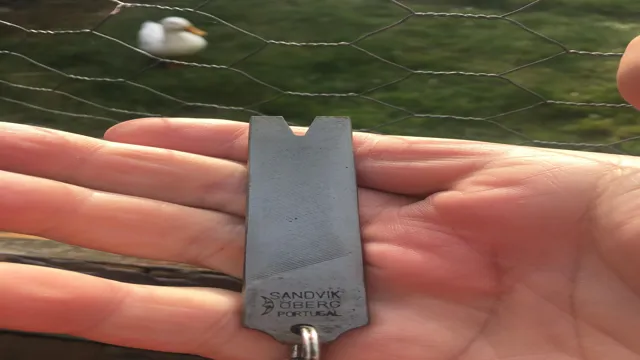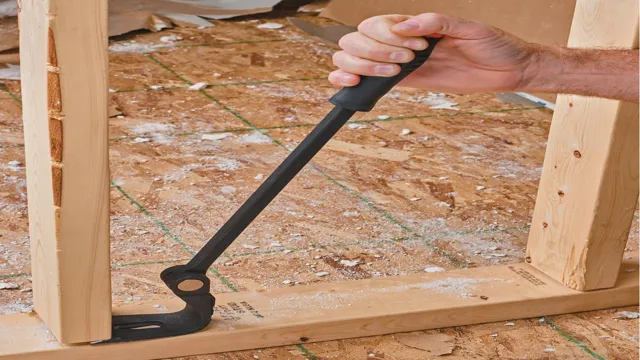How to Make a Pallet Pry Bar: Step-by-Step Guide for Beginners
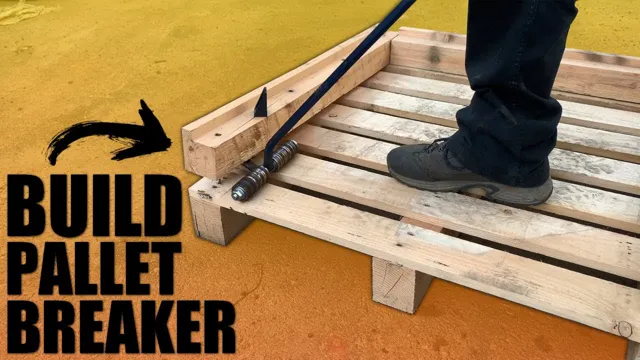
If you’re a fan of repurposing old materials, then you’re probably no stranger to pallets. These wooden structures, commonly used for packaging and shipping, can be transformed into all sorts of useful objects, like furniture, planters, and even garden beds. But what do you do when you need to dismantle a pallet? This is where a pallet pry bar comes in handy.
In this blog post, we’ll show you how to make a pallet pry bar using simple materials that you might already have lying around. With this handy tool in hand, you’ll be able to break down pallets easily and safely, without damaging the wood and losing precious usable materials. So, let’s get started!
Materials Needed
If you’re looking to make your own pallet pry bar, you’ll need a few materials to get started. First and foremost, you’ll need a piece of steel that is roughly 1 inch wide and 1/8 inch thick. This can be found at most hardware stores or metal supply companies.
You’ll also need a handle, which can be made out of wood, plastic, or even another piece of steel. Other materials you may need include a drill, screws, and a saw. It’s important to note that when handling these materials, you should always use safety equipment such as gloves, goggles, and ear protection.
Once you’ve gathered all your materials, it’s time to get to work and create a durable and effective pallet pry bar that will make moving heavy items easier and more efficient.
● Pallet wood
If you’re looking for an affordable and eco-friendly building material, pallet wood could be just what you need. To use pallet wood, you’ll need a few basic tools, including a saw, hammer, and nails. You’ll also need some sandpaper to smooth out any rough edges, and a stain or sealant to protect the wood from rot and insects.
When selecting your pallets, choose ones that are in good condition and free from mold, rot, or insect infestations. Keep in mind that not all pallets are suitable for building – some may be treated with chemicals that can be harmful to humans and pets. Be sure to do your research and choose pallets that are safe and appropriate for your needs.
Once you have your pallets, you can begin to dismantle them and use the individual planks for your projects. With a little creativity and elbow grease, you can transform pallet wood into beautiful and functional furniture, walls, flooring, and more. Best of all, by upcycling this otherwise discarded material, you’ll be doing your part to reduce waste and minimize your environmental impact.
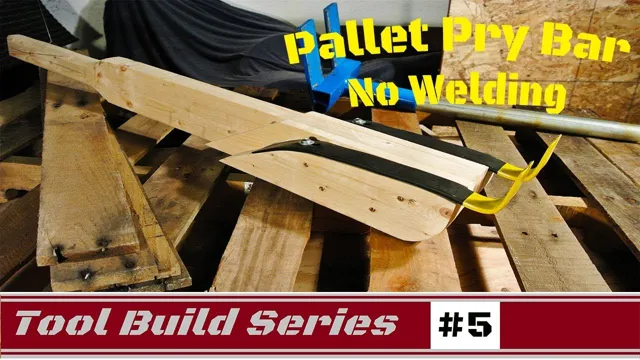
● Circular saw or hand saw
When it comes to building or renovating structures, having the right tools is crucial to ensure efficient and accurate work. One essential tool that you’ll need is a saw. Depending on the scope and type of the project, you can choose between a circular saw or a hand saw.
Circular saws are power tools that can quickly cut through different materials, including wood, metal, and plastic. They’re typically used for larger and more complex projects and provide more precision and speed than hand saws. However, they can be expensive and may require more experience to use.
Hand saws, on the other hand, are manual tools that come in different shapes and sizes and are excellent for small to medium-sized projects. They’re easier to control, less noisy, and more affordable than circular saws. However, they require more time and effort, and the results may not be as precise as those achieved with circular saws.
Ultimately, your choice of saw would depend on your project requirements, budget, and personal preferences.
● Drill and drill bits
When it comes to drilling, the most crucial tools you’ll need are a drill and drill bits. The type of drill you choose will depend on the type of project you’re working on, but for most home-based DIY projects, a cordless drill will work just fine. A cordless drill, as the name suggests, doesn’t require a cord and can be used virtually anywhere.
On the other hand, corded drills provide more power and never run out of battery but are less convenient to use because they need to be plugged in. As for drill bits, there are various options available in the market, each designed for specific purposes. For instance, masonry bits are designed to drill through concrete and brick, whereas wood bits are made for drilling through wood.
Metal bits, on the other hand, can drill through metal surfaces. Investing in a drill bit set that contains different sizes and types of bits is a smart move. It will ensure that you’re always equipped with the right tool for the job.
By having the correct materials on hand, you’ll be able to complete your DIY project quickly and efficiently without any setbacks.
● Wood screws
Materials Needed: Wood Screws When it comes to woodworking projects, wood screws are a must-have material. These screws are specifically designed for woodworking and can hold two pieces of wood together tightly. But, not all wood screws are created equal.
There are several types of wood screws, including Phillips, flat head, and round head screws. Phillips screws have a cross-shaped head and are widely used in woodworking. Flathead screws have a flat top and are ideal for countersinking.
Roundhead screws have a domed top and are commonly used in furniture making. In addition to the type of head, the length, thickness, and material of the screw also vary. Factors like the type of wood being used and the weight of the project will determine which type of wood screw is best suited for the job.
It’s important to select the right screw for the job to ensure the wood pieces are securely fastened together. With the right wood screws and a little know-how, you can create beautiful, long-lasting woodworking projects that will stand the test of time.
● Crowbar or wrecking bar
When it comes to demolition, a crowbar or wrecking bar is an essential tool that should not be overlooked. These versatile tools can help you easily break apart and remove stubborn materials like wood, plaster, and brick. Both crowbars and wrecking bars are made of heavy-duty steel and feature a flattened end for prying and a curved end for leverage.
When selecting a crowbar or wrecking bar, it is important to choose one that is the appropriate size and weight for the job at hand. For smaller projects, a lightweight crowbar may be sufficient, while larger demolition projects will require a heavier wrecking bar. Don’t underestimate the value of these tools when it comes to removing old structures or preparing for a renovation project.
A crowbar or wrecking bar can make all the difference in getting the job done quickly and efficiently.
Step 1: Cut the Pallet Wood
Are you wondering how to make your very own pallet pry bar? Well, the first step is to cut the pallet wood. Using a saw, carefully cut the boards of the pallets to the desired length for your pry bar. Make sure each board is free of any nails or screws that could cause damage to your saw blade.
Once you have all the boards cut to size, you can begin to assemble your pry bar using screws and a drill. Using pallet wood to make a pry bar is a great way to repurpose materials and create a useful tool at the same time. Plus, it’s a fun DIY project that can be done right in your own backyard.
So, go ahead and give it a try! With a little bit of effort, you’ll have your very own pallet pry bar in no time.
● Cut three pieces of pallet wood to desired length
If you’re ready to start building your own pallet wood project, the first step is cutting the wood to your desired size. In this case, you’ll need to cut three pieces of pallet wood to get started. To do this, you’ll want to grab a saw (a circular saw or handsaw will work fine) and measure out your pieces carefully.
Make sure to take into account any imperfections in the wood, and be careful when cutting to ensure straight lines and even edges. Once you’ve cut your pieces to the desired length, you’re ready to move on to the next step in your project! Keep in mind, cutting pallet wood can produce a lot of sawdust and debris, so be sure to wear proper safety gear to protect yourself from any dust or splinters. With a little patience and care, you’ll have your wood cut and ready for the next phase of your project in no time.
● Use circular saw or hand saw to cut the wood
If you’re looking to make DIY projects using pallet wood, the first step is to cut the wood to the desired size. For this, you can use a circular saw or hand saw. The circular saw is a power saw that can make straight cuts with ease, while the hand saw is a manual tool that requires more effort on your part.
Whichever tool you choose, make sure you take safety precautions such as wearing safety glasses and gloves. Once you have your safety gear on, measure the length of the wood and mark it with a pencil. Then, line up your saw blade with the mark and cut.
Repeat this step until you have cut all the pieces you need. Remember, precision is key when cutting wood for your DIY projects. Take your time and make sure your pieces are uniform.
By taking this first step, you’re well on your way to creating beautiful and practical items using pallet wood. Happy cutting!
Step 2: Drill Holes
Now that you have your pallet wood ready to go, it’s time to start drilling some holes to create the perfect pry bar. Using your power drill, make sure to choose the correct bit size for your screws. Then, hold your pallet wood securely and carefully drill two holes about 1 inch apart from each other, closer to the top of the wood.
These two holes will be where you attach your pry bar to the handle. Next, move down to the other end of the wood and drill another hole about one inch from the bottom. This hole will be where you attach a strap or rope to your pry bar to help with leverage.
When drilling, make sure to keep an eye on your depth and be mindful of the wood’s thickness to avoid splintering or cracking. Taking extra care in this step will ensure a sturdy, reliable pallet pry bar that will last you for years to come.
● Drill holes in one end of each piece of wood
Drilling holes in wood may seem like a daunting task, but it’s actually quite simple. To get started, you’ll need a drill and a drill bit that’s appropriate for the size of hole you want. Once you have your tools, measure and mark where you want the holes to be on each piece of wood.
Then, clamp each piece securely to a work surface to prevent it from moving around while you drill. When drilling, be sure to keep the bit perpendicular to the wood and apply steady pressure. If you push too hard, the bit may bind up, while applying too little pressure can cause the bit to jump around.
Remember to wear eye protection and be mindful of your fingers while drilling. After you’ve drilled all the holes, be sure to clean up any wood shavings or debris left behind. This will ensure a smooth finish and prevent any unwanted snags or splinters.
With your holes drilled, you’re now one step closer to completing your woodworking project. So whether you’re a seasoned woodworker or just starting out, drilling holes in wood is a task anyone can tackle with a bit of practice and patience. Before long, you’ll be creating professional-looking pieces that are sure to impress.
● Holes should be large enough for the crowbar or wrecking bar to fit through
When it comes to demolishing something, one of the essential steps is drilling holes. These holes are not just for show; they serve a crucial purpose. The holes should be large enough for the crowbar or wrecking bar to fit through so that you can easily pry the material apart.
It’s essential to understand that you’ll need more than one hole; the number of holes you need will depend on the size of the object or material you’re trying to demolish. To start drilling, get a powerful drill with a good bit. Begin by marking out where you need the holes, ensuring that they’re evenly spaced and not too close together.
Remember, you want to weaken the structure so that it’s easier to remove, but not so much that it collapses. Once you have your marks in place, drill each hole slowly but steadily, ensuring that you get the right depth. You don’t want to drill too far and damage something else behind the material you’re trying to demolish.
In summary, drilling holes may seem like a small part of the demolition process, but it plays a crucial role. It’s essential to make sure that the holes are large enough to accommodate your tools, and that they’re evenly spaced and not too close together. Taking the time to do this correctly will ensure that the rest of the demolition process goes smoothly, and that you can remove the material safely and effectively.
Step 3: Assemble the Pry Bar
Once you have all your materials prepared, it’s time to assemble your pallet pry bar. Start by drilling a hole near the end of your steel pipe, making sure that it is about the same diameter as your bolt. Thread the bolt through the hole, securing it tightly with a nut and washer.
Then, slide the pipe over the pry bar foot and secure it in place with another nut and washer. Tighten both nuts carefully, as you want to make sure that the pry bar won’t come apart as you’re using it. Congratulations, you’ve now successfully assembled your very own pallet pry bar! With a little bit of elbow grease, you’ll be able to take apart pallets in no time at all.
● Place the three pieces of wood together with the drilled ends lined up
In order to assemble your very own pry bar, you’ll first need to gather three pieces of wood and drill one end of each of them. Once that’s done, it’s time to move on to the next step: putting everything together. To do this, simply place the three pieces of wood side by side with the drilled ends lined up.
Make sure they’re flush against each other before securing them with three bolts. Use a wrench to tighten them and ensure that they’re tightly in place. Once the bolts are in, you should have a sturdy and reliable pry bar that can be used for all sorts of DIY projects.
Don’t be intimidated by the process – with a bit of patience and determination, you can easily create your very own tool that will come in handy time and time again. Happy building!
● Secure the pieces of wood together with screws
Now that you have gathered all the necessary materials, it’s time to put them together! This step involves securing the pieces of wood together with screws and assembling the prying bar. First, start by placing the two wooden pieces together so that they form a “T” shape. Next, drill pilot holes along the edges where the wood will be attached to each other.
Once you’ve done that, use screws to secure the two pieces of wood together. Make sure to tighten them well, so they will not loosen up while prying something. After securing the wooden parts together, it’s time to attach the metal rod.
Drill a hole in the center of the wooden piece at the top of the “T” where the rod will be attached. Align the metal rod with the hole you’ve just drilled, and secure it by screwing it in. Once all the parts are assembled, it’s time to test it out and put your new prying bar to good use! With this DIY prying bar, you will be able to tackle any prying project with ease and efficiency.
Step 4: Test the Pry Bar
So you’ve built your very own pallet pry bar, but how do you know it will actually work? Testing it out is the final step in the process, and it’s important to do so before using it on any heavy-duty pallets. Start by finding a pallet to test it on. With the pry bar underneath one of the boards, apply some force to see if it can lift the board off the pallet.
If it does, great – you’ve created a successful tool! If not, double-check the edges of the pry bar to make sure they’re sharp enough to grip the wood. It may also be helpful to try on a different pallet, as some may be more difficult to disassemble than others. Remember to always use caution and wear protective gloves when working with pallets to avoid any potential injuries.
With your newly created pallet pry bar, you’ll be able to effortlessly disassemble pallets, and repurpose the wood for your own DIY projects.
● Use the pry bar to lift or separate pallets
When it comes to pallet lifting, a pry bar can be an incredibly useful tool. But before you start using it, it’s important to make sure it’s in good condition and can handle the job at hand. To test your pry bar, first, give it a visual inspection to make sure there are no cracks, chips, or bends.
Next, use your hand to grip the bar and gently apply pressure to see if it feels sturdy. If the pry bar passes these initial tests, you can then move on to applying more pressure to see how much weight it can handle. It’s important to find a balance between applying enough pressure to properly lift a pallet while also making sure you don’t exceed the pry bar’s weight limit.
Once you’re satisfied with its strength, you can confidently use the pry bar to lift or separate pallets. With a sturdy pry bar in hand, tackling heavy loads will become a breeze!
● Make any necessary adjustments or repairs
Once you have selected your pry bar, checked its condition, and prepared the work surface, it’s time to move on to the next step – testing the pry bar. This is especially important if you are using it for the first time or have made any repairs to it. To test the pry bar, apply a moderate amount of force to the object you are trying to pry.
If the bar flexes or bends excessively, it may not be strong enough to handle the task at hand. Conversely, if it does not flex at all, you may need to exert more force or switch to a larger pry bar. Therefore, it is important to find the right balance.
Additionally, check the pry bar for any signs of damage after each use. If you notice any wear and tear, cracks, or other defects, it is essential to make the necessary adjustments or repairs before continuing to use the tool. So, don’t overlook this crucial step, and ensure your pry bar is up to the task to get the job done safely and effectively.
Conclusion
In conclusion, making a pallet pry bar is as easy as 1, 2, 3 (or should we say “pallet, pry, bar”). With just a few simple tools and materials, you can transform a humble pallet into a useful and versatile tool that will make your woodworking projects and DIY endeavors a breeze. So, next time you’re wondering how to make the most out of your pallets, remember that a little bit of creativity and elbow grease can go a long way.
Happy upcycling, and may your pallet pry bar be the envy of all your DIY friends!”
● Making a pallet pry bar is a simple and affordable DIY project
Once you’ve completed your pallet pry bar, it’s important to put it to the test to ensure that it’s sturdy and can handle the heavy lifting. You can use it to pry apart a few pallets or even try to remove nails from some wood planks. If you notice any bending or damage to the pry bar, it’s important to address those issues before using it again.
Remember, safety is always the top priority when working with tools, so make sure you’re wearing the appropriate protective gear and using the pry bar correctly to avoid any accidents. With a little bit of practice, you’ll be able to master the art of using a pallet pry bar in no time. Happy DIY-ing!
● Use caution when using the pry bar to avoid injury
When using a pry bar, it’s important to exercise caution to avoid potential injuries. Here’s how to properly test the pry bar before using it. First, make sure that the pry bar is securely in place before you begin using it.
Start by placing the pry bar on a sturdy surface and firmly apply pressure to see if it moves or flexes. If the pry bar feels too flimsy or doesn’t hold up to the pressure, it’s best to replace it with a sturdier one. Keep in mind that using a damaged pry bar can lead to injuries or accidents, and it’s always better to err on the side of caution.
With these tips in mind, you can ensure that you’re using your pry bar safely and effectively.
FAQs
What materials do I need to make a pallet pry bar?
To make a pallet pry bar, you’ll need a steel pipe, angle grinder, welding machine, and safety equipment.
How long should my pallet pry bar be?
The length of your pallet pry bar should be around 36 inches to give you enough leverage when removing pallet boards.
Can I use a regular pry bar instead of a pallet pry bar?
While you can use a regular pry bar, a pallet pry bar is specifically designed to remove boards from pallets without damaging them.
How do I attach the steel pipe to the pry bar?
After cutting off the end of the pry bar with an angle grinder, weld the steel pipe to the remaining end of the pry bar.
Can I make a pallet pry bar without welding?
If you don’t have access to a welding machine, you can use bolt cutters to cut a hole in the pry bar to insert the steel pipe.
Will a pallet pry bar work for all types of pallets?
While a pallet pry bar is designed to work for most standard pallets, certain heavy-duty or custom pallets may require a different tool.
Can I buy a pallet pry bar instead of making one?
Yes, you can purchase a pallet pry bar from hardware stores or online retailers if you don’t want to make one yourself.

